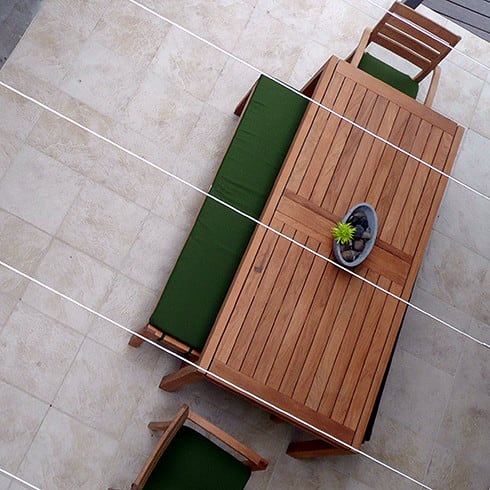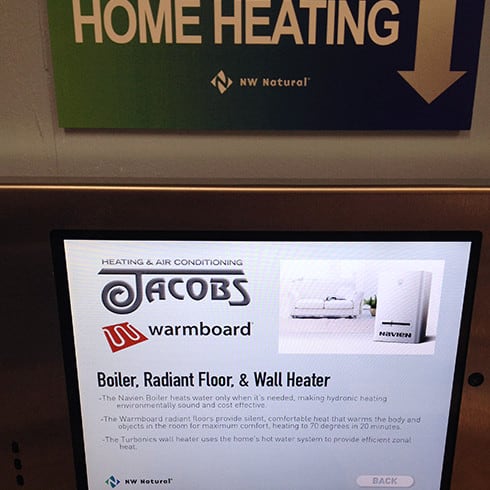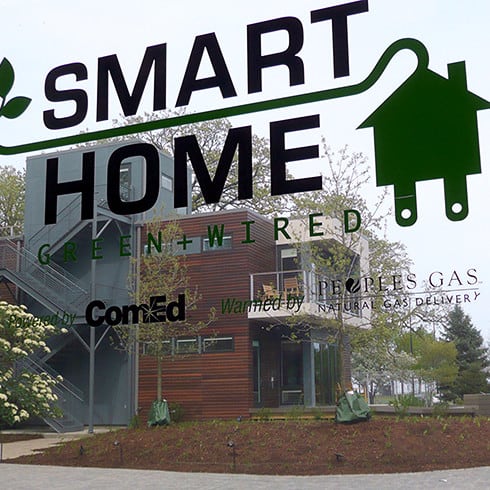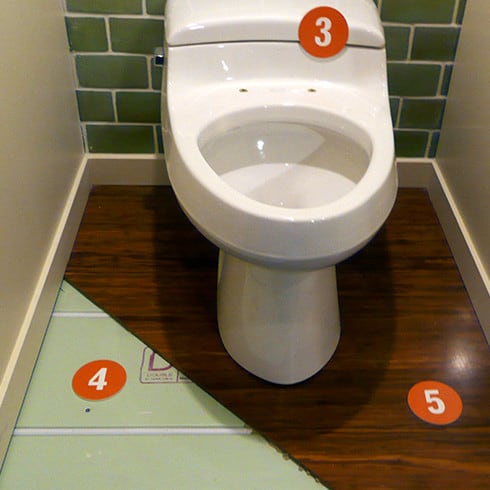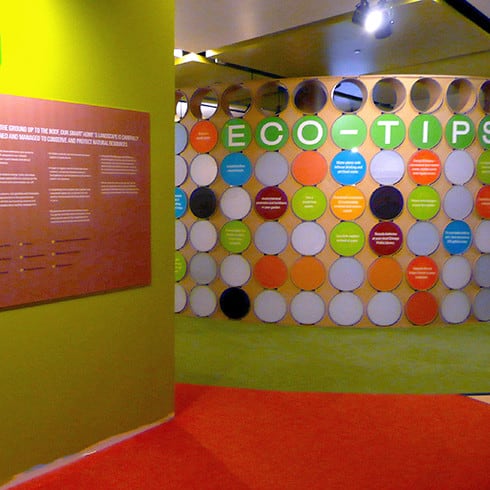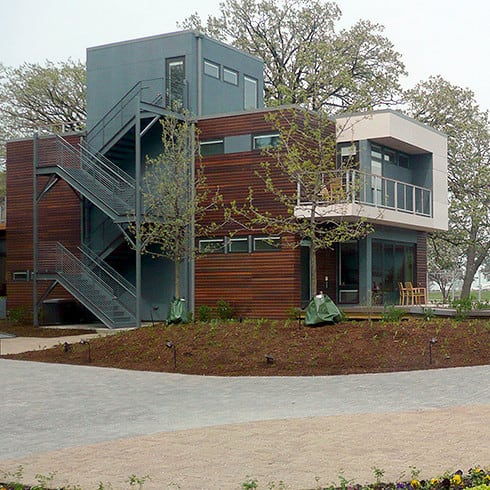When the Museum of Science & Industry in Chicago, IL, decided to construct a house – on museum grounds – that could demonstrate the current state of the art in intelligent sustainable housing, radiant floor heat was an obvious choice towards that goal. The Museum calls this exhibit, Smart Home: Green + Wired.
Chicago Museum of Science + Industry: 2011 Smart Home

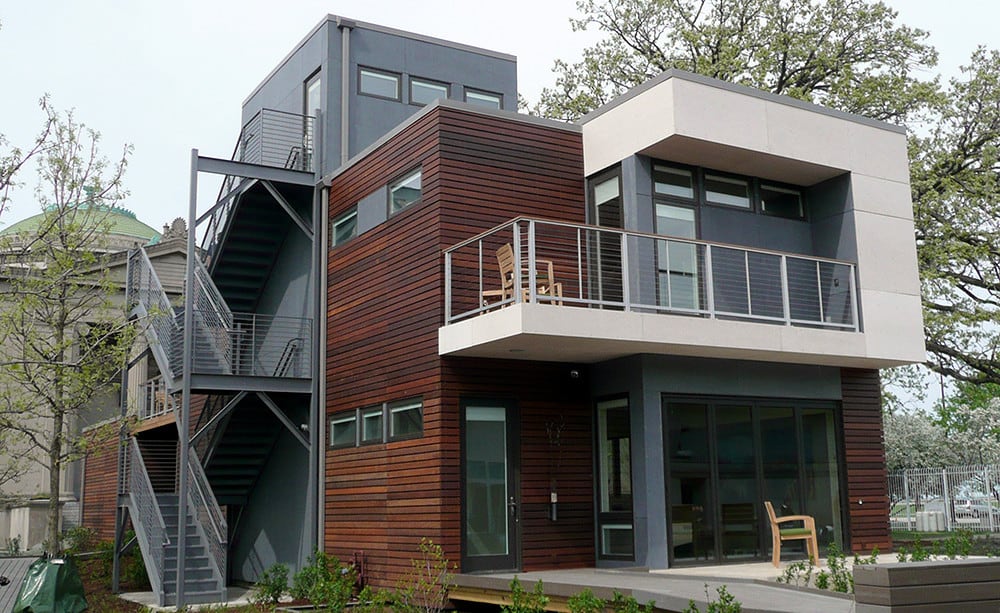
Type:
New concept home
Location:
Chicago, Illinois
Total Square Footage:
2,336 square feet
Floor Covering:
Natural stone, tile, bamboo
Energy:
Solar electric, wind and natural gas
Most people might imagine a small, minimalist structure, given the fact that the home would be an actual exhibit. Perhaps because sustainable design has become such an essential component in 21st century residential architecture, the Museum chose to illustrate some of the possibilities that exist in “smart home” living, by commissioning a significant home of a size appropriate for a typical American family
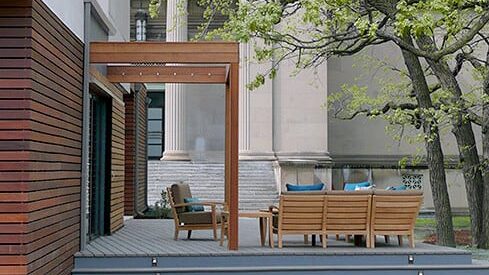
At three stories and 2,336 square feet, the Smart Home is nothing short of an architectural and energy efficient dream home. Visually stunning and at the pinnacle of eco-friendly, Smart Home was built using the highly efficient building methodology of modular construction.
For energy sources, Smart Home relies on wind power and solar technology, along with natural gas. High ceilings, warm materials, clean lines along with abundant natural light and breezes make the home feel even more spacious. A full-home, automated smart technology system enables homeowners to control heat, window coverings, lighting, security sensors and cameras, as well as track electricity, gas and water consumption in real-time. The 2,336 square-foot, Smart Home was designed to “let the green in” and emphasized great spaces for entertaining, a master bedroom that serves as a retreat, a whimsical nursery/playroom and a functional home office. The design features soft , organic textures and colors fused with a contemporary style. Toured by over 600,000 Museum of Science & Industry visitors since its debut, Smart Home provides examples and ideas for sustainable living with contemporary style in harmony with the environment.
Architect
Michelle Kaufmann Studio
Michelle Kaufmann is an architect, designer and advocate for smarter ways to design, build and live. Her mission with all of her work is to make thoughtful, sustainable design accessible. With her firm, Michelle Kaufmann Studio, she specializes in sustainable lifestyle design including single family homes, eco-luxury resorts, and multi-family communities. She is also a consultant for builders, developers and architecture firms on sustainability and prefabrication. Working to help extend education and awareness about the beauty of sustainable design, Michelle has had a number of her homes showcased in museums. A full-size replica of Michelle’s home, the Glidehouse® home was built at the National Building Museum as part of the exhibit The Green House, and a fully functioning 3-story mkSolaire® home is on display at the Museum of Science and Industry. Her work has also been on display at MOCA, the Walker Art Center, and the Vancouver Art Center.
“I got involved with Smart Home when the amazing team at the Museum of Science and Industry had an idea to do a fully functioning 3-story home that would help to educate and inspire people about sustainable and smart building. They were looking at the National Building Museum in DC’s The Green Home exhibit, which included a full-size replica of my house as a part of the exhibit. After seeing that, they called me. We worked together on some ideas and then All American® (the modular factory) joined up as well. It was a very exciting and fun (and intense) process.
There isn’t a particular style to Smart Home, it isn’t a style per se, but it’s designed with the environment in mind. There are high ceilings and a 3-story open section in the middle designed to sculpt in light as well as allowing hot air to rise, keeping the house cool with the chimney effect. And having flat roofs (well, with slight slopes) so we can have inhabitable decks and green roofs. This makes double use out of every square inch, including space that is typically wasted on the roof. Windows are strategically placed to ‘wash’ the surfaces with light so artificial lighting is not required during the day (i.e. windows washing the countertops with light, high windows washing the ceilings with light, windows that go all the way to the floor to wash the floor with light, etc.). And we also used Nanawall accordion glass doors that allow the walls to fully open to the outdoors, making the interior space feel larger. Creating a healthy interior environment is important to us, so we chose radiant heating which avoids the problems with forced air and maintaining high levels of indoor air quality.
We also chose to have all hard flooring surfaces (stone for lower level, tile in bathrooms, and strand woven bamboo upstairs) with non-off gassing rugs and carpet tiles that can be washed. This can be much better than wall to wall carpet which can be tough to truly clean. We are a big fan of Warmboard’s approach to radiant floor heating, and have used it in about 10 or more projects. It is smart, efficient, and works well with modular construction. There is little waste and construction is made easier. Plus, it can work with all of the flooring materials that we like to use. Aesthetically, it leaves the space visually clean without having to have vents.” – Michelle Kaufmann
Michelle Kaufmann Studio
Builder
All American Homes
All American Homes was founded in 1970 and is one of the nation’s leading builders of residential systems-built (modular) housing. Each custom-built home is made of superior materials, by carefully trained craftsmen, using the latest technologies in a controlled environment. Homes are protected from weather and vandalism during the construction process. It arrives to the site about 70 to 85% complete, and in most cases is set on its permanent foundation and locked the same day.
“All American Homes construction translates into significant savings for homeowners because controlled construction saves time and money. Systems-built home construction allows owners to plan, predict and control costs through better scheduling and more accurate planning. “We were contacted by Michelle Kaufmann Designs and the Museum of Science + Industry about getting involved with Smart Home and immediately got to work, collaborating to design and build the project. One of the biggest challenges was using several products that were new to All American Homes. We researched the products to educate ourselves as well as working closely with each of the vendors to ease the introduction of their product into our construction process. Though we’d had previous experience with radiant, this was our first build using Warmboard. We found that Warmboard works better with our construction process versus other radiant products because it is the subfloor and was quite simple to install and incorporate into the modular building process. And, because of Warmboard’s ‘pre-routed sheathing,’ we did not need to alter our construction process. Warmboard is one of the more user-friendly radiant options available. All American Homes is honored to be the builder of the Smart Home. This project helped expand our product offering to include modern stylings and energy efficient and sustainable products.” – Stacey Miller
All American Homes
Project Owners
Museum of Science + Industry, Chicago, IL
Science and Industry, Chicago opened its doors in 1933. That same year, Chicago hosted a spectacular celebration of human innovation: The Century of Progress World’s Fair. One exhibit from that fair, the “Homes of Tomorrow” display, unveiled visionary building methods and technologies like prefabricated homes and solar-powered heating. Today, green practices lead modern industry and it is the Museum’s ongoing mission to provide its guests with information about these practices and relevant, hands-on experiences.
“When we decided to showcase the future of eco-friendly architecture, only a real home demonstrating the cutting edge in green technology and sustainable materials would do! We contacted architect Michelle Kaufmann, one of the country’s most innovative designers of sustainable green homes, and All-American Homes, an industry leader in superior modular home construction, and we knew we had the blueprint for an extraordinary exhibit experience: a real, fully functioning eco-home right here at the Museum. We wanted to create a home that was as energy efficient as possible while maintaining a superior level of comfort and Warmboard fit in really well with that vision. We needed to be energy efficient and as environmentally responsible as possible, while providing that high level of comfort for the user. Warmboard created a very efficient, moderate in cost, in floor radiant heating system, that perfectly melded with the entire Smart Home concept, architecture, building process and end result. Warmboard also worked really well with the floor coverings we chose: stone, tile and bamboo.”- David R. Mosena President and CEO and Anne Rashford The Museum of Science and Industry
The Museum of Science and Industry
57th Street and Lake Shore Drive
Chicago, IL 60637
Understanding Radiant Technology
Terry Alsberg, CEO of Warmboard
Of the many thousands of Warmboard homes I’ve been involved in, for personal and historical reasons, I find the Chicago Museum of Science and Industry’s Smart Home to be one of our more intriguing projects. I first studied modular building as an architecture student several decades ago, when my University of Illinois professors touted it as the future of residential architecture.
When this museum opened in 1933, it featured a modular home exhibit, because even back then, the efficiencies of system built homes were envisioned. Shortly after WWII, William Levitt revolutionized home building efficiency by building 33,000 affordable homes, split between his two Levittown’s, one in Pennsylvania and one on Long Island. Those that may know of the Levittowns may not know that they were all radiant heated. Although today, radiant has a reputation of being a premium heating system with a premium price tag, in 1947 Levitt chose radiant for his homes because he modularized his radiant systems to achieve a lower cost solution to home heating. In the process of proving to thousands of Levitt own homeowners that efficiently installed low cost radiant could lower their heating bills, those same homeowners came to love the quiet and invisible comfort of warm floors. So it was exciting to go back to the future with Michelle Kaufmann and All American Homes by participating in creating a home that may become a model for affordability and sustainability as we go forward into the 21st Century.
As a 4×8 structural panel, Warmboard-S can be sawn and nailed like any conventional subfloor, and it integrated smoothly into All American Homes system built approach to modular construction. System built homes, are typically composed of several modules that are constructed separately in a controlled environment factory then married together at the final site. Because the loop patterns typical of any radiant system allow the heating system to be broken up into discreet areas of 300 sf or less, it was easy to pre plumb the radiant system into the various individual modules with minimal additional interconnection work performed at the final site as the modules are married together.
Compared to old fashioned high mass concrete slab based radiant systems, Warmboard’s low mass combined with it’s toughness as a 1-1/8” seven layer Doug Fir plywood panel travels easily and safely on the highway to the site. But Warmboard is far more than merely an easy to use product. The same low mass that allows it to be transported easily ensures greater comfort because a low mass system can adjust its output quickly and accurately to match changing heat loads. Accurate control means constant temperatures, which ensures constant comfort. And, it saves energy by avoiding the wasteful overheating that can come from a high mass system. The AIA in it’s recommendations for sustainability strongly recommends radiant floor heating which is always more energy efficient than forced air. Warmboard maximizes the efficiencies of radiant, because its thick, highly conductive aluminum surface allow us to use the lowest water temperatures in the radiant industry. So our aluminum faced plywood panels not only suited the modular construction requirements of this home, Warmboard was essential to the smart energy use theme of the project.
